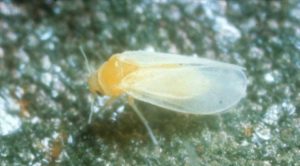Whitefly Is Focus of First Known Plant-to-Insect Gene Transfer

Silverleaf Whitefly, Bemisia tabaci.
Photo courtesy of W. Billen, Pflanzenbeschaustelle, Weil am Rhein
The whitefly, a pernicious pest familiar to almost any greenhouse grower, owes some of its reputation to a gene pilfered from its plant host millions of years ago.
This research finding, according to an article on Nature.com, is the first known example of a natural gene transfer from a plant to an insect. It also explains one reason why the whitefly Bemisia tabaci is so adept at munching on crops: the gene that it swiped from plants enables it to neutralize a toxin that some plants produce to defend against insects.
Early work suggests that inhibiting this gene can render the whiteflies vulnerable to the toxin, providing a potential route to combating the pest.
“This exposes a mechanism through which we can tip the scales back in the plant’s favor,” says Andrew Gloss, who studies plant-pest interactions at the University of Chicago. “It’s a remarkable example of how studying evolution can inform new approaches for applications like crop protection.”
The diminutive whitefly — which is more closely related to aphids than to flies — wreaks agricultural havoc around the world. Bemisia tabaci is among the most destructive plant pests: whiteflies sup sugary sap from hundreds of types of plant, all the while excreting a sticky, sweet substance called honeydew that serves as a breeding ground for mold. Whiteflies are also vectors for more than 100 pathogenic plant viruses.
Read more here.








